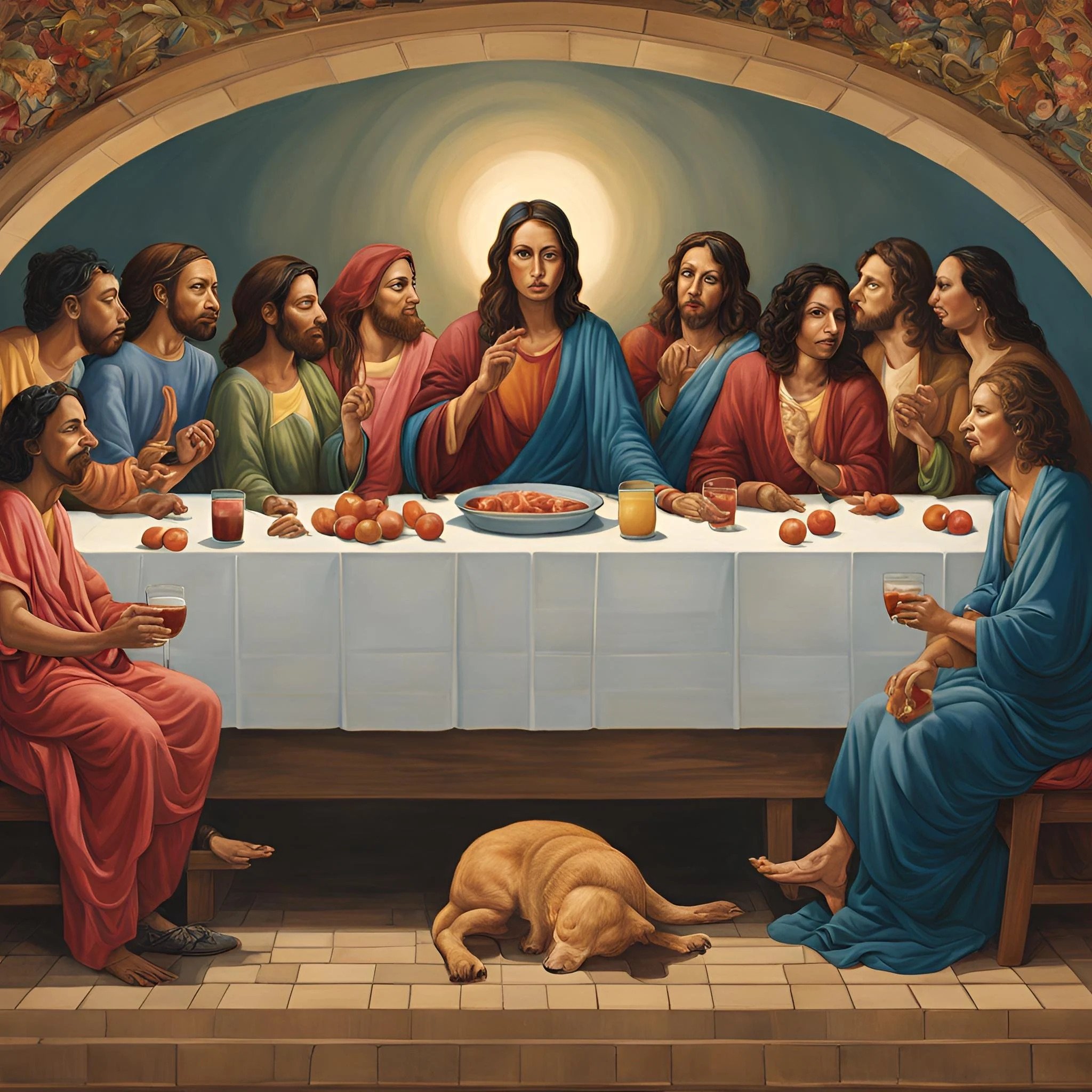When I teach a religious studies class, I try to pull something from the headlines to use for discussion. You know, something religion-y to get students thinking about religion’s continuing ubiquity and importance in the world today.
Had I been teaching a class at the end of July 2024, there would have been only one option for that thing: the opening ceremony of the Paris Olympics.
Not the bells ringing at Notre Dame Cathedral and not Sequana, goddess of the river Seine, galloping in gleaming silver with the Olympic flag. Worthy topics, to be sure. But none was more worthy of discussion — if social media were the measure of things — than a living tableau of LGBTQ+ performers posing in what seemed to be (or…possibly not) a recreation of Leonardo da Vinci’s “The Last Supper.”
It created some conversation and controversy, to say the least. And rather than adjudicating the right- or wrongness of the artistic choice, the ins and outs of the potential offense, whether the portrayal was Ancient Greek or Renaissance Italian, or the dynamics of French secular culture, global Catholicism and U.S. evangelical culture (again, all worthy topics), I would have used the kerfuffle as a case study in the power of the image and the power of satire in the world of religion.
The power of image
With or without religion, images are powerful. They move us to anger, they move us love; they move us to buy, they move us to believe.
And in his eponymous book, religion scholar David Morgan discusses the power of the “sacred gaze” — a way of seeing that invests an object (an image, person, time or place) with spiritual significance. Across a variety of religious traditions, Morgan traces how images in different times and spaces convey beliefs and produce religious reactions in human societies – what he calls, “visual piety.”
As human products, images and religious ideas have grown together, with some images having the power to determine personal practice and identifications, rituals and notions of sacred space. As “visual instruments fundamental to human life,” images have their own materiality and agency. Think of the ubiquitous statue of the Buddha sitting in backyard or the glittery gold calligraphy of “Allah” or “Muhammad” hanging over a family’s living room; the brightly colored images of Ganesha and Krishna or a copy of Eric Enstrom’s “Grace” hanging in kitchens and cookhouses across the U.S.
Each of these images serve as markers of a whole range of social concerns, devotional piety, creedal orthodoxy or gender norms.
So too with da Vinci’s “Last Supper.” As one of the most well-known religious images the world over, the painting is not a part of any Christian canon. It isn’t even an accurate representation of what the Last Supper, as recorded in the Christian Gospels, would have been. Jesus’ disciples were not Renaissance European white men, they were probably not pescatarians, nor were they seated on one side of the table (or seated at that kind of table at all). But as a myth we knew we were all making, and as the National Gallery’s Siobhán Jolley pointed out on X, the painting morphed from being a sign (a painting portraying an interpretation of biblical texts) to a signifier (a bearer of meaning so pronounced that it came to visualize Jesus’ last meal with his followers for many).
And in our contemporary culture(s), such visual cues carry a particular kind of power. In a highly visual society, bombarded by the rapid consumption of images on screens of varying size and intensity, images can transcend one context and speak to many — as did the recreation of da Vinci’s “Last Supper” (or…maybe not) when it resonated both positively and negatively with so many.
As a visual quotation of a popular image, we translated its meaning and the image spoke with power to various communities and subcultures. It tore people up and took the internet by storm. It manifested opprobrium and offense, celebration and adulation, as it was read as a sacrilege of the highest offense or as a symbol of vibrant tolerance and pleasing subversiveness. Along the way, it created a whole range of responses, on what is and what is not offensive, what is and is not idolatry, what is and is not Christian privilege, what is and is not persecution; the list could go on and on.
For all that it was (or was not), the Opening Ceremony moment (and it was, after all, but a blip on the screen) illustrated once again the power of religious images, even in increasingly secular societies.
The power of satire
In addition, whatever the performance was meant to represent, it was almost certainly meant as a form of satire.
A genre with generations of history, religious satire’s power lies in its ability to direct the public gaze to the vice, follies and shortcomings of religious institutions, actors and authority writ large. Whether calling out hypocrisy or corruption, religious satire has been used for centuries to take religious elites or established traditions to task.
Examples of savage satire and nipping parody abound across religious history. From the Purim Torah and its humorous comments read, recited or performed during the Jewish holiday of Purim to "Paragraphs and Periods,”(Al-Fuṣūl wa Al-Ghāyāt) a parody of the Quran by Al-Ma‘arri or the Canterbury Tales by Geoffrey Chaucer or Robert Burns’ poem “Holy WIllie’s Prayer,” authors and authorities, playwrights and poets have wielded scalding pens to critique what they see as the hypocrisy, self-righteousness and ostentation of religious communities.
As such, satire has been powerful as a means of protest both from without and within religious traditions. For example, the 16th-century rebel German monk and Reformer Martin Luther used his caustic touch to call what he thought were abuses within the Catholic Church to task. Jeering and flaunting his way through theological controversies and the dogmatic discussions of his day, Luther was not one to skirt the issue or back away from using humor and satire to prove his point. In fact, he was well known for his use of scatological references, offending his followers and opponents with vulgar references to passing gas and feces.
Each of these examples shows how satire relies on a combination of absurdity, mimicry and humor to highlight the problems its creators see with religious actors’ or institutions’ behaviors, vices or social standing.
To that end, the opening ceremony’s display was religious satire par excellence, insofar as it pushed a particular social agenda and advocated for certain recognitions for a marginalized community through its exhibition. The living display not only created a stir but captured the public imagination, sparking discussion and debate about Christian privilege, European culture and the acceptance and affirmation of LGBTQ+ individuals in religious communities. In this way, religious satire can also help create community and a sense of belonging among those who are in on the joke and jive with the critique embodied in the satire.
The persistent power of religion
The debate around the tableau will (hopefully) die down in the days and weeks to come (and perhaps already has in a media cycle that serves up a fresh controversy every 24-hours). But if I were to point to just one lesson in my religious studies classroom, I would highlight how the scene — for all it was or wasn’t — proved once again the power of images and satire in the field of religion.
It is another case study in how, even at supposedly “secular” events in a decidedly “secular” country, religion — and the primary and secondary images and satire thereof — remains persistently present and ubiquitously potent. And that, dear students of religion, is something to keep in mind for the next controversy, which is sure to come sometime soon.




















